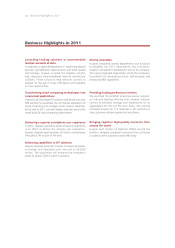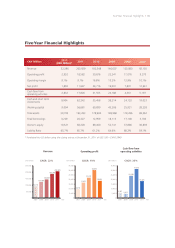Huawei 2011 Annual Report Download - page 20
Download and view the complete annual report
Please find page 20 of the 2011 Huawei annual report below. You can navigate through the pages in the report by either clicking on the pages listed below, or by using the keyword search tool below to find specific information within the annual report.15 /
can collectively manage access networks, metropolitan
area networks, and backbone networks to provide fast
service provisioning, precise fault location, and improved
O&M efciency. The U2Net architecture provides carriers
with the ubiquitous ultra broadband networks that are
easy to operate and manage.
In 2011, Huawei continued to maintain its leadership
position in the fixed-line network field, consolidated
its superiority in the optical access and transport
network markets, and rapidly strengthened its position
in the carrier IP and microwave network markets.
In the FTTx access network field, Huawei launched
a giga digital subscriber line (DSL) prototype and
a 40G passive optical network (PON) prototype.
Huawei was the rst company to provide site-specic
vectoring solutions around the globe. In the ODN
field, Huawei innovated continuously and effectively
resolved the difficulties in deployments and O&M of
optical networks. Huawei has deployed more than 60
iODN commercial networks around the world. In the
carrier IP network eld, Huawei has entered into deals
with and provided services for over 20 mainstream
European carriers, occupying a large proportion of
the market share in the global carrier network market.
Huawei unveiled the world's rst 200G high-speed line
card for routers, which was awarded the Broadband
Innovation of the Year Award by InfoVision in 2011.
Huawei also released a distributed router operating
system and a cluster router with a capacity of 25 Tbit/
s to satisfy emerging demands in the era of video
and cloud computing. These offerings are the most
advanced core router technologies in the IP field.
In the field of optical transport networks (OTNs),
Huawei deployed 100G OTN solutions for large-scale
commercial use and secured 15 commercial contracts
for the same solution. Furthering its momentum,
Huawei deployed more than 300 metropolitan OTNs in
over 200 cities around the globe. Huawei dominates
the global microwave network market and continues
to set the pace in IP microwave networks. Huawei is
also leveraging its core competencies in convergence
and visibility in O&M to bolster transformations and
innovations in All-Service Operations in the All-IP era.
As of the end of 2011, Huawei had been awarded
eight national broadband project contracts globally,
further attesting to its strong capabilities in end-to-end
solutions. These projects will provide users with richer
ultra-broadband services than ever before.
Global Services
In the services eld, Huawei continuously helps customers
achieve business success by listening attentively to
customers, thoroughly understanding their business
operational processes, stepping up investment and
development initiatives for professional service solutions,
and improving end-to-end delivery capabilities. In 2011,
revenue from Global Services amounted to CNY34,705
million.
The fast-moving information society challenges and
reshapes the traditional approaches for network planning,
network construction, and O&M. Traditional network
construction and O&M systems, which simply focus on
KPIs of network equipment, are being transformed into
systems which focus on services, applications, and user
experiences, and which support integration as well as the
operations of end-to-end networks and services. Through
close strategic collaboration with customers in completing
seamless evolutions, improving user experiences, achieving
operational excellence, and increasing revenue, Huawei
provides efficient, innovative service solutions and
new business models to assist customers in optimizing
their end-to-end operations and ensuring sustainable
business success. Notably in O&M and user experience
solution development, we have been more innovative
and strengthened cooperation with industry standards
organizations such as TM Forum and achieves service
innovations. Our cooperation efforts are evidenced by
our Managed Services Unified Platform (MSUP) being
certified and recognized by TM Forum. Our SmartCare
service solution that delivers the ability of service quality
management on an aggregated Per Service Per User (PSPU)
basis helps carriers manage and improve user experiences.
In 2011, Huawei was awarded the Global Growth and
Innovation in Telecom Managed Services of the Year
Award and the Excellence in Customer Perception of
Service Quality Award from Frost & Sullivan.
Following thorough research on the relationships
between user experiences, service quality, and network
quality, we provide the HUAWEI SmartCare service
solution. Based on an aggregated Per Service Per User
experience improvement capabilities, this solution aims
to help carriers focus on innovation to build a customer-
centric management practice, ensure excellent user
experiences and operating efficiency, and increase
business value.
Management Discussion and Analysis
























